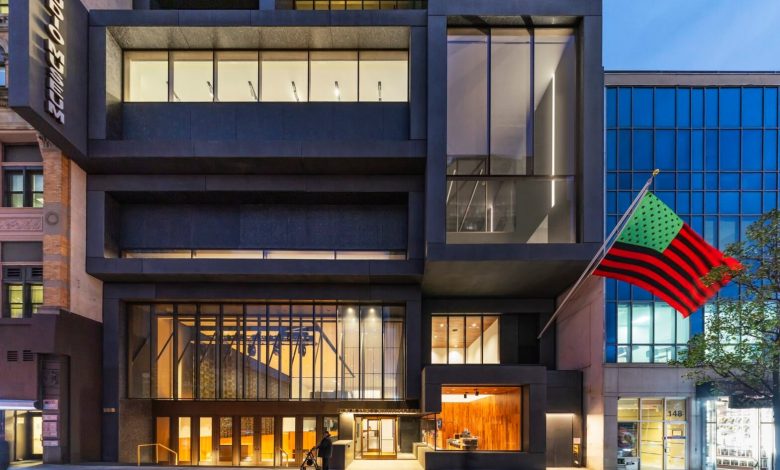Studio Museum In Harlem’s Brilliant New Chapter Includes You

“Today, we welcome a new future for ourselves by staying true to our past,” said Thelma Golden, the Studio Museum in Harlem’s Ford Foundation Director and visionary Chief Curator.
“This building says to the world: Harlem matters. Black art matters. Black institutions matter,” declared Board Chairman Raymond J. McGuire, silencing any doubt.
And Chief Program Officer Natasha Logan describes the feeling simply: “The ancestors would be proud.”
After seven years without a physical home and over half a century of reshaping how we understand Black artistic expression, the Studio Museum in Harlem unveils its first purpose-built space. It’s an elegant homecoming and a bold statement in a neighborhood that has always been a global destination, now more elevated by the power of its new landmark.
A Building Born From Harlem
The showstopper — designed by Adjaye Associates, the firm behind the National Museum of African American History and Culture in D.C., in collaboration with Cooper Robertson, architects of the Whitney Museum of American Art — rises on 125th Street in the exact spot the museum stood for decades until construction began. For Golden, relocating was never a question: “We knew, and our public knew, that this site, which the museum has occupied since the early ’80s, is where we belong.”

In quiet, graceful ways, the building is a love letter to the community it’s rooted in, winking at visitors, loving them back. “Through many deep and inspiring conversations between Thelma Golden and David Adjaye, this vision evolved into a reimagining of Harlem’s own vernacular architecture: the sanctuary, the stage, the streets, and, of course, the stoop — all places of gathering, expression, and belonging,” remarked Pascale Sablan of Adjaye Associates New York.
For now, the building itself is the undeniable star. Made for the possibility of masterpieces on every wall, the curatorial restraint currently allows you to see the architecture as the work of art it is. And then, on top of it all — literally — there’s the Terrace. It’s sexy, with a splash of meaning (hosting the Thelma Golden Light Well) and overlooking Manhattan with a view that, though breathtaking like many, sings with a coolness no other roof in New York can deliver.

Inaugural Exhibitions Honor Legacy
The dedicated exhibition spaces are excitingly unique, starting with what many have already dubbed the “sanctuary,” the museum’s third-floor gallery. Christening the new room is Tom Lloyd, an exhibition full of the artist’s pioneering electronic light sculptures, which inaugurated the original Studio Museum in 1968. The works now float on the barrel-vaulted, 28-foot-high gallery walls.
“From the very beginning, we envisioned having [Lloyd’s works], ‘Veleuro’ and ‘Moussakoo,’ installed on the upper register of these walls as a way to show the possibilities of the space, but also because an art critic from the 1960s talked about light work as being ‘the stained glass of the electronic age,’” Curator Connie Choi tells Travel Noire.

All of the inaugural exhibitions trace where the museum has been and where it’s going. Lloyd’s work anchors the opening, alongside From Now: A Collection in Context, a “shifting” installation of Black artistic achievement, and From the Studio, showcasing works by more than 100 alumni of the Artist-in-Residence program.
Access For All
Although the building is fabulous to the max, also noteworthy is the museum’s commitment to accessibility in an era when new, gleaming additions increasingly price out the communities they claim to serve. As Logan notes, “That point of entry and access — there was never a debate about that.”
For travelers and art lovers planning trips to New York, a visit to the Studio Museum isn’t optional. The institution has always been more than a museum; it’s been a laboratory, a sanctuary, and, as Golden puts it, the place “where Black art lives.”
Now it has a home worthy of that legacy, one that feels both monumentally ambitious and deeply intimate. Whether you’re discovering Tom Lloyd’s technological abstractions for the first time, encountering Faith Ringgold or Glenn Ligon’s iconic works in the collection, or simply sitting on the “reverse stoop,” inside these walls, you can feel a magic in the air.

The new Studio Museum in Harlem proves that cultural institutions can expand without displacing, can honor legacy while embracing innovation, and can build something permanent in a neighborhood that has always balanced progress with history.
When asked what she hopes visitors feel when they walk through the doors for the first time, Golden tells Travel Noire: “I want them to come to the Studio Museum and feel welcome in this space that is completely devoted to the vision and voices of Black artists.”




